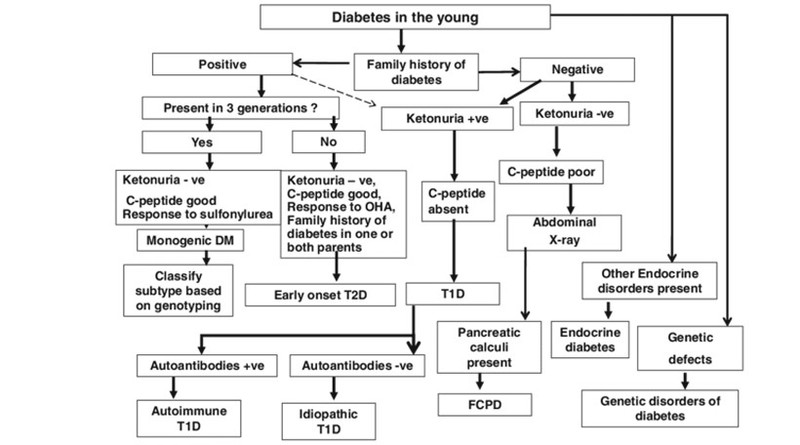Type 1 Diabetes and Managing its Effects
M3 India Newsdesk Jul 24, 2024
Type 1 diabetes mellitus is caused due to severe or absolute deficiency of insulin. Hence, individuals with type 1 DM require lifelong insulin therapy to prevent complications and have a healthy life. Patient education and counselling play an important role in managing the diseases.
Type 1 diabetes can be defined as a condition in which there is a severe or absolute deficiency of insulin due to beta cell destruction of the pancreas.
Pathology
Studies suggested that in individuals with Type 1 DM, T-cell mediated autoimmune destruction is triggered by certain environmental factors that result in beta cell injury and depletion of beta cell mass.
Epidemiology
Type 1 DM accounts for 5-10% of all diagnosed diabetes, of these, around 40-60% of patients with Type 1 DM are younger than 20 years of age at onset.

Clinical features
- Abrupt onset of polyuria, polydipsia, and weight loss
- Diabetic ketoacidosis
- Abdominal pain, fatigue, febrile illness
- Muscle cramps, infections (eg: boils, UTI), behavioural disturbances, poor school performance
- Lean Body
- A family history of diabetes in parents is usually absent
- Low C-peptide level
- High blood sugar and GHbA1c
- Glutamic acid decarboxylase, islet antigen-2, zinc transporter or other islet cell autoantibodies may be present
- The patient requires lifelong insulin from onset to control hyperglycemia, maintain good health, and survive
Diabetic Ketoacidosis (DKA)
DKA is an acute life-threatening complication commonly seen in Type 1 DM, caused by absolute or severe insulin deficiency. Hyperglycemia, hyperketonemia, and metabolic acidosis are its defining characteristics.
Pathogenesis of DKA
Insulin deficiency leads to hepatic overproduction of glucose, release of free fatty acids into circulation from adipose tissue(lipolysis), and unrestrained hepatic fatty acid oxidation to ketone bodies with resulting ketonemia and metabolic acidosis.
Hyperglycemia results in osmotic diuresis leading to dehydration and loss of electrolytes. Sodium depletion occurs due to poor renal sodium reabsorption.
Metabolic acidosis leads to loss of intracellular potassium in exchange for hydrogen ions and insulin deficiency also causes potassium loss from cells, thus leading to severe hypokalemia.
Signs of DKA
- Dehydration
- Hypotension, shock
- Ketosis
- Acidosis
- Precipitating cause ( pneumonia, UTI)
- Hypothermia
- Gastric stasis
Treatment
- Correction of dehydration, hyperglycemia, electrolyte imbalances and identification of precipitating events.
- Rehydration with isotonic saline (0.9% NaCl) at 15-20 ml/kg body weight per hour during the first hour. The choice of replacement fluids that follow is determined by the level of hydration, serum electrolyte levels and urinary output. The success of fluid replacement is observed by haemodynamic monitoring, measurement of fluid input/output and clinical examination. Within the first 24 hours, estimated shortfalls should be corrected by fluid replacement.
- Sodium deficit is corrected by normal saline. After renal function is confirmed, 20–30 mEq/L of potassium (2/3 KCl and 1/3 KPO4) should be infused until the patient is stable and able to take oral supplements.
- The recommended dose of an intravenous bolus of regular insulin is 0.1 U/kg body weight and continuous infusion of regular insulin is 0.1 U/kg/hr. The optimal rate of glucose reduction should be between 50 and 70 mg/hr. If this is not achieved in first-hour insulin doses may be doubled to maintain a steady decline in glucose level.
- Signs of cerebral oedema and myocardial infarction shall also be ruled out.
Other complications
- Neuropathy
- Nephropathy
- Retinopathy
- Gum diseases
- Foot problems
Prevention of complications
- Regular insulin intake
- Medical nutrition therapy
- Physical exercise
- Regular physician follow-up
- Regular blood glucose monitoring
Disclaimer- The views and opinions expressed in this article are those of the author and do not necessarily reflect the official policy or position of M3 India.
About the author of this article: Dr Rinkal Solanki is a Consultant Diabetologist at Madhushanti Diabetes Clinic, Surat.
-
Exclusive Write-ups & Webinars by KOLs
-
Daily Quiz by specialty
-
Paid Market Research Surveys
-
Case discussions, News & Journals' summaries